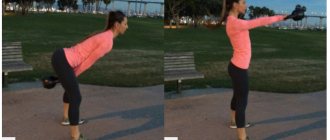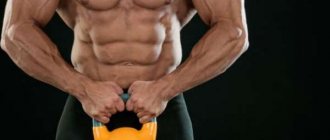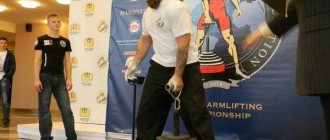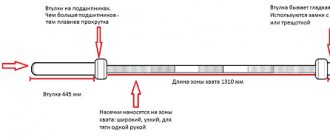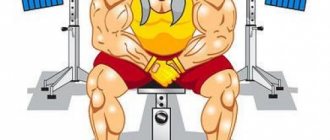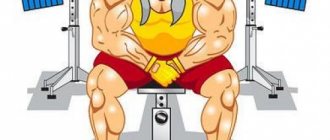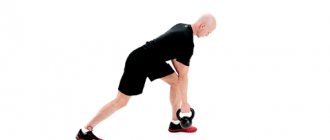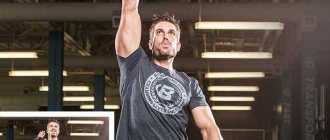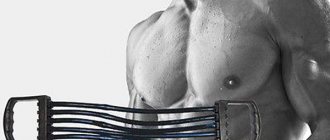Since in Russia there is only one kettlebell lifting federation, which holds competitions on the territory of the Russian Federation and assigns categories - the All-Russian Kettlebell Lifting Federation, its rules for kettlebell lifting will be in this article.
- Nature and program of competitions
- Competition participants
- Equipment and inventory
- Judicial panel
- Rules for performing exercises
Nature and program of competitions
Nature of the competition
1.1. By nature, kettlebell lifting competitions are divided into: a) personal, b) team, c) personal-team. In personal competitions, only the participant’s personal result is counted and his place in the competition is determined in accordance with this. In team competitions, the results of the team as a whole are counted and the team’s place is determined accordingly. In personal-team competitions, the results of one participant and the team as a whole are counted separately, and the personal places of the participants and teams are determined in accordance with this. 1.2. The nature of the competition in each individual case is determined by the Regulations on the competition. 1.3. Competitions with weights of 16.24 and 32 kg are carried out according to the program: - push of two weights from the chest (short cycle), - push of two weights from the chest with lowering in a hanging position after each lift (long cycle), - jerk of the weight alternately with one and the other hand, - classic biathlon (jerk and snatch) - team competitions (relay races).
Competition program
1.4. The competition program is determined by the Regulations and must be drawn up so that the athlete can compete in no more than one of the events and the relay on one day. 1.5. The winner is determined in each weight category, both in individual exercises and in classical biathlon by the largest amount of lifts. In the snatch, the average result of the sum of the lifts performed with one and the other hand is taken into account. If several athletes have the same number of lifts, the advantage goes to: - the participant who has a lower body weight before the performance, - the participant who has a lower body weight after the performance, - the participant who performs ahead of the opponent by lot. 1.6. Places in the team championship are determined based on the results of the qualifying participants in one of the ways determined by the Regulations (according to tables of equalizing coefficients, according to places in the individual championship).
Kettlebell lifting, by its specificity, is a cyclic sport, with a fairly long duration of work in competitive conditions. A weight lifter must lift weights (weights) for 10 minutes at the highest possible pace; accordingly, the leading motor quality in this sport is strength endurance. All this is reflected in the specifics of the training process in kettlebell lifting. In addition to training strength abilities, a weight lifter also needs to develop aerobic endurance. According to regulatory documents, those who are at least 12 years old are allowed to engage in kettlebell lifting.
The content and specificity of training in kettlebell lifting is determined by the age and qualifications of those involved. At the initial stages of kettlebell lifter training, general physical training tools predominate for the development of strength (exercises with weights) and endurance (running, outdoor games). The use of this kind of means allows us to ensure the formation of a physical base for subsequent in-depth specialization. Special exercises with weights are used to a lesser extent; the main emphasis in their use is on mastering the technique of competitive exercises. As the level of training of the trainees increases, the share of special exercises increases, the intensity of the load increases, the focus of the training process on in-depth specialization is observed, and the share of general physical training decreases.
The main means of training in kettlebell lifting are exercises that can be divided into competitive, special-preparatory and general developmental. Also, in relation to kettlebell lifting, some experts use a simpler classification of exercises: exercises with weights and exercises without weights. A number of exercises used in the training process of weightlifters are borrowed from other sports.
General developmental exercises are presented both as means for developing aerobic endurance and as means of strength training. To train endurance, weightlifting training includes running for medium and long distances. To increase the effectiveness of running exercises, the whole range of endurance training methods is used: continuous-uniform (running a distance at a constant speed), continuous-uneven (running a distance with periodic accelerations) and interval (running a distance several times with strictly limited rest intervals). As part of strength training, exercises with various weights are used for the main muscle groups; preference is given to basic exercises (presses, rows, squats, pull-ups, bends, etc.), exercises from weightlifting can also be included in the training. Exercises to develop strength are usually performed with rest intervals until complete recovery; the weight of the weight is usually 40% - 80% of the maximum, while exercises with a weight of 40% are recommended to be performed at the highest possible pace.
Competitive and special-preparatory exercises include a set of various exercises with weights. Competitive and special-preparatory exercises with kettlebells are used to improve a complex of motor abilities specific to kettlebell lifting. Competitive exercises are represented by a kettlebell snatch and a kettlebell push in a long and short cycle. Special preparatory exercises include various options for lifting weights similar to competition ones in terms of technique, rhythm and tempo of work, alternating tension and relaxation of various muscle groups. Special preparatory exercises can be performed with one or two weights, and the weight of the apparatus can vary widely. Based on the specifics of competitive activity, within the framework of the educational and training process, competitive and special preparatory exercises can be performed using various methods, which are selected depending on the tasks solved by the athlete in a given period of sports training. In kettlebell lifting, as part of special work, the following training methods are used: uniform, variable, interval, repeated and competitive. The uniform method involves performing competitive and special-preparatory exercises at the same pace, with the exercise being performed once. The pace of the exercise is determined based on the heart rate readings. The heart rate at the end of the exercise should be approximately 75% of maximum (220 beats/min minus age). The main goal of this method is to increase the aerobic capacity of the athlete’s body. The alternating method involves performing several sets of an exercise with kettlebells of different weights. In the first half of the approaches, the weight of the kettlebell increases, and in the second half it decreases. In this case, a constant pace of performing the exercise must be maintained, and the number of repetitions is determined individually. The alternating method is intended primarily to increase the strength component of the complex of motor abilities of a weightlifter and improve exercise technique. The interval method involves performing exercises in short bursts, which are alternated with strictly regulated rest periods. This method is used to increase the pace of the exercise. There are two variants of the interval method: sprint (duration of each series is 15 - 30 seconds at maximum pace), tempo version (duration of each series is 1-2 minutes). This method is also preferable for experienced athletes. The repeated method involves performing an exercise with several approaches, the duration of each approach is less than in competitions and ranges from three to five minutes. Rest intervals between approaches last until the athlete fully recovers. This method is also effective for improving exercise technique. The competitive method involves performing an exercise with a duration and tempo as close as possible to the competition conditions. This method is used for direct preparation for competitions, determining your maximum at the current time. The choice of a specific method depends on the planned volume and intensity of the load, the ability of the athlete’s body to adapt to physical activity.
In addition to mastering the technique of competitive exercises and training the athlete’s motor abilities, in order to achieve a high result, it is important to achieve a high ability to operate all body systems that ensure oxygen consumption and utilization, which in turn makes it necessary to master the skills of proper breathing when performing special exercises. According to widespread recommendations, you should breathe through your mouth, deeply and rhythmically, and exhale fully and intensely. When performing a kettlebell snatch, while lifting the weight from the starting position, a deep breath is taken, when the kettlebell is at the top, an exhalation is made and a small inhalation is made, when the kettlebell is lowered down, a deep exhalation is made - during one cycle of the kettlebell jerk, two inhalations and two exhalations are made. When performing a push of weights in the starting position, inhale, when doing a half squat, exhale deeply, then before pushing out, inhale, in the position of fixing the weights, exhale and inhale a little, when lowering the weights to the chest, exhale deeply—three breaths are taken in one cycle of pushing the weights and three exhalations.
Educational and training sessions in kettlebell lifting are built according to the classic three-component scheme: preparatory part, main part and final part. In the preparatory part of the lesson, athletes perform a general warm-up of the body; this may also include specialized exercises with light weights to prepare athletes for a specific load. The duration of the preparatory part is on average 15 minutes. As part of the final part, in order to speed up the recovery processes, stretching of the main muscle groups and special exercises for compression relief of the spine are performed. The final part lasts about 10 minutes. The main part of the lesson is the training itself and consists of several groups of exercises performed in a certain sequence. Analysis of the training programs of weightlifting athletes shows a significant variety of training schemes used, but most often at the beginning of the main part, competitive exercises are performed, after which special preparatory exercises can be performed, at the end of the main part, as a rule, general developmental exercises for the main muscle groups are performed. The ratio of the volume of different groups of exercises is mainly determined by the qualifications of those involved. The duration of the main part is 1 - 2 hours.
Within the framework of a weekly microcycle of a kettlebell lifter, from 3 to 6 training sessions are carried out. Each lesson includes 4 - 8 exercises from all groups. Considering the long duration of special exercises with weights, the number of approaches is usually small and ranges from 1 to 4. Rest intervals between approaches can be ordinary (until complete recovery) and hard (time limited) - determined by the training method used.
The design of training complexes in kettlebell lifting is carried out according to certain rules. When describing a training task, a number of parameters are indicated: serial number, name of the exercise, weight of the apparatus, number of repetitions and approaches, rest time and work time. The name of the exercise can be written in full or in the form of abbreviations: P - snatch, T - short cycle jerk, DC - long cycle jerk. The weight of the projectile is indicated in kilograms. The number of repetitions can be specified specifically as a number or as a percentage of the maximum achieved. Work time and rest time are written in minutes or seconds. Also, the training task may indicate an important parameter of the weightlifter’s load - the pace of the exercise in the form of the number of lifts per minute. The above components are not always fully represented in the training task; only those that are necessary in a particular case can be indicated. For example, the weight of the apparatus may not be indicated, which implies performing the exercise with a standard weight of weights for a given time at a certain pace. Also, the time of work and the number of repetitions are not indicated at the same time (instead of repetitions, the pace of the exercise or the duration of the work may be indicated). If the exercise is performed once, then the number of approaches is not written. The rest time between approaches is indicated when performing an exercise with time-limited rest intervals. Considering all of the above, it becomes clear that the design of the task will differ when using different training methods. For example, a training task when using the uniform training method may look like this:
1. Jerk: 24 kg / 8 in min / 10 min or 1. T 24 kg / 8 in min / 10 min
which means: “Exercise number one is a 24 kg weight push, perform at a rate of 12 lifts per minute for 10 minutes.” The design of a training task using a variable training method might look something like this:
1. Clean and jerk: 24 kg / 10 min; 28 kg / 10 per min; 32 kg / 10 per min; 28 kg / 10 per min; 24 kg / 10 per min
which means: “Exercise number one, kettlebell push, perform at a pace of 10 lifts per minute, five approaches with kettlebells 24 kg, 28 kg, 32 kg, 28 kg, 24 kg.” The design of a training task using the interval training method may look like this:
1. Jerk: 32 kg / 50 / 120 sec / 3 or 1. Jerk: 32 kg / 60% / 120 sec / 3
which means: “Exercise number one, push of 32 kg weights, perform 50 times (60% of the maximum), three approaches, rest interval between approaches is 120 seconds.” The design of a training task using the repeated method is as follows:
1. Snatch 24 kg / 60 / 2 or 1. Snatch 24 kg / 60% / 2
which means: “Exercise number one, jerk a 24 kg weight, perform 60 times (60% of the maximum), two approaches.” Completing a task using the competitive method is quite simple:
Clean and jerk 32 kg / max / 10 min or Snatch 32 kg / max / 10 min
which means: “Perform a push (snatch) of a 32 kg weight as many times as possible in 10 minutes.” The design of general developmental exercises is carried out in a standard form: the name of the exercise and the number of approaches multiplied by the number of repetitions. For example:
Squats with a barbell on the shoulders: 3x15
which means: “Perform squats with a barbell on your shoulders 3 sets of 15 times, select the weight yourself.” Below, as an example, is a training complex for a kettlebell lifting lesson designed according to a similar scheme:
1. Double kettlebell push: 24 kg / 80% / 120 sec / 3 2. Kettlebell snatch: 24 / 70% / 120 sec / 2 3. Overhead barbell press: 3x15 4. Squats with a barbell on the shoulders: 4x10 5 Bends over pommel horse: 3x20 6. Torso bends lying on the floor: 2xmax
It should be noted that the above schemes for designing training tasks and complexes in kettlebell lifting are not exhaustive, which is explained by the wide variety of approaches to designing training tasks among specialists in this sport.
As an example of organizing the training process in kettlebell lifting, we can cite several plans for weekly microcycles. The first training plan is presented as a weekly microcycle of three sessions and is intended for beginner weightlifters; the author’s terminology is preserved:
Monday
1. Jumping from a low squat with a kettlebell behind the head: 16 kg x 10-15 times / 2 2. Two-handed kettlebell snatch: 24 kg x 10-15 times / 2 3. Double kettlebell push press: 16 kg x 10-15 times / 2 4. One-arm kettlebell snatch: 16 kg x 10-15 times / 2 5. Double kettlebell deadlift: 16 kg + 16 kg x 10-15 times / 2
Wednesday
1. Squats with weights on the shoulders: 16 kg + 16 kg x 8 times / 2 2. Raising two weights on the chest from the floor: 16 kg + 16 kg x 10-15 times / 3 3. Half squats with weights on the shoulders: 24 kg + 24 kg x 10-15 times / 3 4. Bench press: 3 x 10-15 times 5. Kettlebell push-ups with toes out: 16 kg + 16 kg x 10-15 times / 3 6. Overhead push-up : 3x10-12 times 7. Hanging on the bar for a while: 2x1 min
Thursday
1. Kettlebell swings with changing hands: 24 kg x 10-15 times / 2 2. Standing kettlebell row to the chin: 16 kg x 10-15 times / 2 3. Snatch of one kettlebell with both hands: 24 kg x 10-15 times / 2 4. Kettlebell snatch with one hand: 16 kg x 10-15 times / 2 5. Standing bends with a kettlebell in hands: 24 kg
The following training plan is presented in the form of a microcycle of four sessions and is designed for more prepared athletes, the author’s terminology is preserved:
Monday (low load)
1. Kettlebell swings with changing hands: 24 kg / 40% / 2 2. Snatch: 24 kg / 50% / 3 3. Walking with kettlebells in the hand below: 2x60 s 4. Squats with a barbell on the shoulders: 3x6-8 5. Body lifts lying on a goat: 2x12-15 6. Cross training 1 km
Tuesday (average workload)
1. Clean and jerk: 24 kg / 60% / 4 2. Shung press: 3x10-12 3. Walking with weights on straight arms at the top: 2x30 s 4. Bent-overs with a barbell in hands: 3x10-12 5. Half squats with a barbell: 3 x 20 6. Cross training 2 km
Thursday (heavy load)
1. Clean and jerk: 24 kg / 70% / 3 2. Snatch: 24 kg / 50% / 2 3. Walking with weights in the hands below: 2x60 s 4. Squats with a barbell on the shoulders: 3x6-8 5. Bent-overs with a barbell in arms: 3x10-12 6. Standing barbell press: 2x20 7. Cross training 1 km
Friday (average workload)
1. Snatch: 24 kg / 70% / 3 2. Walking with weights in the hands below: 2x30 3. Squats with a barbell on the shoulders: 3x6-8 4. Lifting the body while lying on a goat: 2x12-15 5. Bringing the legs to the bar: 2x10
When planning training sessions, the weight of the load is indicated as a percentage most often when working with large groups of athletes; with an individual approach, instead of percentages, specific numbers for load values can be substituted, which in some cases is more convenient and practical.
When assessing the level of training load in kettlebell lifting, its volume is taken to be the number of weight lifts or the sum of kilograms lifted (tonnage) for the assessed training period. The intensity of the training load can be taken as the weight of the weights, the rate of lifting, and the number of repetitions as a percentage of the maximum. Planning the volume and content of the load in kettlebell lifting is carried out taking into account the specific stages of long-term training and taking into account the age and individual characteristics of those involved. The alternation of training loads of different levels at different periods of the training process is carried out in compliance with the principle of cyclicity, the nature of the means used varies over a wide range and is determined by the current tasks of sports training.
Competition participants
Age of participants
The following athletes are allowed to compete: - boys and girls up to 16 years old, - boys and girls up to 18 years old, - juniors and junior women up to 22 years old. - men and women over 22 years old, the participant’s age is determined by the year of birth (as of January 1 of the current year). Weight categories Competition participants are divided into the following weight categories:
| Boys | Senior boys | Men, juniors | Girls (junior) | Older girls | Women, juniors |
| up to 48 kg | up to 58 kg | up to 63 kg | up to 48 kg | up to 53 kg | up to 58 kg |
| up to 53 kg | up to 63 kg | up to 68 kg | up to 53 kg | up to 58 kg | up to 63 kg |
| up to 58 kg | up to 68 kg | up to 73 kg | up to 58 kg | up to 63 kg | up to 68 kg |
| up to 63 kg | up to 73 kg | up to 78 kg | St. 58 kg | St. 63 kg | St. 68 kg |
| up to 68 kg | up to 78 kg | up to 85 kg | — | — | — |
| up to 73 kg | up to 85 kg | up to 95 kg | — | — | — |
| St. 73 kg | St. 85 kg | up to 105 kg | — | — | — |
| — | — | St. 105 kg | — | — | — |
Each participant has the right to compete in only one weight category at specific competitions. It is allowed to compete in a different weight category only in team competitions (relay race), subject to re-weighing.
Applications
Before the start of the competition (a day before), applications for participation in the competition and completed participant cards are submitted to the Main Judicial Panel (secretariat), where the credentials commission is held to admit participants and teams to the competition. The application must be certified by the head of the sports organization and a doctor. The procedure for weighing participants 2.1. Weighing of participants is carried out on the eve of the competition and lasts 1 hour. Participants competing in team competitions (relay races) are allowed to participate in individual competitions based on the weigh-in results. 22. Weighing is carried out in a room specially designated for this purpose. Members of the Main Jury, one official representative from each team, are allowed to be present during the weigh-in. 2.3. Weighing of participants is carried out by judges providing judging for the competition. 2.4.Participants are weighed naked or wearing swimming trunks. If, during weighing, an athlete’s weight goes beyond the boundaries of the weight category, the athlete has the right to be weighed again within the framework of the time regulations allotted for weighing athletes of this weight category. 2.4. When passing the credentials committee or during the weigh-in, participants are drawn to determine the order of entry onto the platform and a technical application is submitted. Rights and obligations of the participant 2.7. The participant has the right to contact the Main Jury on all issues only through a representative of the Team or a judge in front of the participants. 2.8. The participant has the right to prepare weights for performing the exercise before being called to the platform. The preparation of weights is carried out in a place designated for this purpose. When preparing weights and hands, only magnesium is allowed. 2.9. The participant has the right to be a representative of an enterprise or firm in advertising its products. The participant or team representative must notify the organization conducting the competition about this. The main panel of judges and obtain permission for this. 2.10. The participant must know the competition rules and competition regulations. 2.11. If generally accepted rules of behavior or public order are violated during competitions, the participant is given a warning; in case of repeated violation, by decision of the jury he may be removed from participation in the competition. 2.12. The participant is obliged to strictly observe discipline, to be correct in relation to other participants, as well as spectators and judges. A participant who did not show up for the performance. Not allowed to compete. Participants who have won prizes are required to wear full sports uniform for the award ceremony. 2. 13. The participant prepares and performs with weights installed on the platform on which he must go. 2.14. The participant is prohibited from using any equipment. making it easier to lift the weight(s). 2.15. The participant is prohibited from talking while performing exercises and approaching the judge on the platform after performing the exercise. 2.16. A participant who, due to health reasons, is withdrawn by a doctor from one of the types of the program, is not allowed to further participate in these competitions.
Athletes uniform
Athletes are required to perform in uniform, which must be clean, smart, and meet the following criteria: - The suit can consist of one or two parts, cycling shorts, weightlifting tights, T-shirt or tank top; - T-shirt sleeves should not cover the elbow joints; — it is allowed to use a standard weightlifting belt no more than 12 cm wide, bandages no more than 1.5 m long. The width of bandages on the wrist should be no more than 10 cm. On the knees no more than 25 cm. The use of knee pads and bandages is allowed. The belt cannot be worn under a competition costume - sports shoes can be optional; — teams must be in uniform. Representatives and team captains 2.17. An organization participating in individual and team competitions must have its own representative. 2.18. The representative is the team leader, bears full responsibility for the organization and discipline of the participants, is obliged to attend all meetings held by the main panel of judges with representatives, ensure the timely attendance of participants at competitions, opening and closing parades, doping control and awards. 2.19. A team representative may be present at the weigh-in and draw of lots for the team members he represents. 2.20. The representative is prohibited from interfering with the actions of judges and persons conducting the competition. The representative has the right to submit statements and protests to the panel of judges. Applicable only to members of your team. Protests are submitted before the next change of participants leaves. 2.21. If the members of a team do not have a representative, his duties are performed by the team captain.
Stages of development of kettlebell lifting
Every sport has its roots. Some are just emerging, while the origins of others begin in the distant past. Likewise, exercises with kettlebells, having deep roots in the distant past, in their modern understanding, as kettlebell lifting exercises, were expressed quite recently.
Ex-president of the International Kettlebell Lifting Federation V.S. Rasskazov (2004) divides the development of kettlebell lifting into three periods. 1st period - from the end of the 17th century, when weights weighing 1, 2, 3 pounds were used to demonstrate strength and prowess at various festivals, fairs, and later in circuses. 2nd period - from October 24, 1948, when the 1st All-Union Strongman Competition was held in Moscow, the program of which included competitions with two-pound weights. And, although competition rules were not developed, there was no sports classification, competitions began to be systematic. They were under the patronage of weightlifting specialists, who saw weightlifting competitions as a means of attracting young people to weightlifting. 3rd period - 1962 - modern history of kettlebell lifting, when the first competition rules were developed, kettlebell lifting was included in the sports classifications of national sports in Russia, Ukraine, and then other republics of the former USSR.
V.A. Polyakov and V.I. Voropaev (1988) in the book “Kettlebell Sport” describes the First All-Union Strongman Competition, which was held in Moscow in 1948. Athletes competed in the snatch of a two-pound weight with one hand and in the clean and jerk of two weights from the chest in weight categories up to 60, 70, 80 and over 80 kilograms.
In the weight category up to 60 kg, Muscovite Grigory Konovalov won. His results: snatch – 28 lifts, clean and jerk – 7 lifts. In the weight category up to 70 kg, Ivan Solomakha (Voroshilovograd) won. His result in the snatch is 23 and in the clean and jerk 15 lifts. The strongest in the weight category up to 80 kg was Leningrader Alexander Lavrentyev with a result of 30 snatches and 13 chest lifts. Nikolai Bolshakov from the city of Chkalov showed the best result in the snatch - 33 and in the chest lift - 19 (V.A. Polyakov and V.I. Voropaev, 1988).
Based on the limited available literature on kettlebell lifting, we can conclude that it began to emerge as a separate sport in the late 40s of the last century.
However, the authors (V.A. Polyakov and V.I. Voropaev, 1988; V.S. Rasskazov, 2004, etc.) consider the 60s to be the period of formation of modern kettlebell lifting, when in the RSFSR, Ukraine, Lithuania in rural areas teams in our country increasingly began to organize competitions.
For a long time, competitions in kettlebell lifting exercises were held according to different rules. In order to popularize it among all segments of the population, the rules were changed towards simplification.
This continued until 1985. Kettlebell lifting was included in the Unified All-Union Sports Classification of 1985-1988. as equal in rights with other sports. As noted by the authors V.A. Polyakov and V.I. Voropaev (1988), a commission for kettlebell lifting and athletic gymnastics was created at the USSR Weightlifting Federation. Through the efforts of enthusiasts (B. Vishnyauskas, V. Voropaev, V. Polyakov, V. Rasskazov) all-Union competition rules and category standards were developed (including a standard giving the right to be awarded the honorary title “Master of Sports of the USSR”).
The result of the efforts of both professionals and amateurs of kettlebell lifting was the first championship of the Soviet Union in the city of Lipetsk in November 1985. The champions of the Soviet Union were: M. Rodionov (up to 60 kg, Lipetsk), A. Vorotyntsev (up to 70 kg, Lipetsk), F. Usenko (up to 80 kg, Sumy), A. Moshchennikov (up to 90 kg, Perm), S. Mishin (over 90 kg, Kaluga). At this championship, Sergei Mishin pushed two two-pound weights from his chest 100 times (V.A. Polyakov and V.I. Voropaev, 1988).
The popularity of kettlebell lifting increased every year. 223 athletes from 14 union republics took part in the 1987 USSR Championship.
The last USSR championship was held in the city of Brest in 1992. The last champions of the USSR were: Sergey Mishin (Russia), Viktor Shvidky (Ukraine), Roman Mikhalchuk (Ukraine), Alexander Malkov (Russia), Ivan Amendt (Kazakhstan), Valery Fedorenko (Kazakhstan) (V.S. Rasskazov, 2004).
In the 2002 directory of the All-Russian Kettlebell Lifting Federation, the chronicle of Russian kettlebell lifting championships dates back to 1984. On November 26, 1984, the first official Russian championship took place in the city of Orenburg in three weight categories: up to 60, 80 and over 80 kg. The first champions of Russia, respectively, in the weight categories were Tsepelev (Kirov) - 64 lifts, Rakhmanov (Perm) - 105 lifts and Mishin (Kaluga) - 131 lifts in the double event. It should be noted that the legendary Honored Master of Sports Sergei Nikolaevich Mishin, performing at the 2005 Russian Championship in a separate push exercise, showed the result of 160 lifts and became the champion in the weight category over 90 kg at the age of 47 years.
In 1989, new rules were introduced limiting the time for performing each exercise to 10 minutes.
Since 1998, they began to hold Russian championships in the long cycle push and jerk of two kettlebells. The first championship took place on February 20-22, 1998 in St. Petersburg. The championship was held in seven weight categories with 32 kg weights.
Russian championships in biathlon among youth began to be held in 1999 (May 22-23, Babaevo).
In November 2001, in Babaevo, Vologda Region, the Russian championship among women was held for the first time in three weight categories - up to 60, 70 and over 70 kg. The competition was held in one exercise - snatch with a 16 kg kettlebell, the sum of lifts of two arms was counted. Representatives of the Altai Territory became champions in all weight categories: E. Kapustina (up to 60 kg, 213 lifts), S. Chesnokova (up to 70 kg, 191 lifts), S. Ekimenko (over 70 kg, 186 lifts).
To increase the entertainment value of the competition, leading weightlifters in Russia proposed introducing relay races in the classic clean and jerk and long cycle clean and jerk into the competition programs. Relay races began to be held at the conclusion of the competition. Each team member performs lifts at a maximum pace for three minutes, while competing with members of other teams. The total number of lifts of all team members is taken into account when determining the winning team. Since 2002, relay races have been included in the programs of championships, cups and championships of Russia.
The year 2003 is notable for the inclusion of kettlebell lifting in the program of the First Summer Spartakiad of Russian Students, which indicates its high importance in promoting the health and physical development of students (M.I. Ponarsky, 2003).
Due to the increased loads on athletes during performances in classical combined events, when in each weight category competitions in the classic clean and jerk and snatch are held on the same day, experts began to look for ways to reduce the maximum loads experienced by weightlifting athletes.
At many seminars and conferences the question was raised: why can’t there be separate performances only in the clean and jerk and snatch?
The answer to this question was the first Russian Championship in 2005 in individual exercises (January 28-29, Rybinsk). However, the strongest became the strongest even with this form of competition.
The chronicle of the world kettlebell combined championships has been going on since 1993. This year the first world championship was held in the city of Lipetsk. The championship was held in six weight categories, with weights of 32 kg. The result in the snatch was counted as double the amount of the number of lifts with the weak arm. The champions in their weight categories were: in the weight category up to 60 kg – Vasily Zaitsev (Russia, 119 (clean and jerk-68, snatch-51)); up to 65 kg – Roman Mikhalchuk (Ukraine, 159 (87+72)); up to 70 kg – Mikhail Kobzev (Russia, 173 (107+66)); up to 80 kg – Fedorenko Valery (Kazakhstan, 225 (127+98)); up to 90 kg – Salahiev Fanis (Russia, 219 (131+88)); over 90 kg – Sergey Mishin (Russia, 245 (168+77)).
Honored Masters of Sports of Russia in kettlebell lifting are currently: Mikhail Bibikov (Orenburg), Mikhail Kobzev (Rybinsk), Sergey Kirillov (St. Petersburg), Sergey Leonov (Ulan-Ude), Andrey Kravtsov (Elets), Evgeny Lopatin (St. Petersburg), Sergey Mishin (Kaluga), Alexey Pivovarov (Rybinsk), Sergey Rachinsky (St. Petersburg), Fanis Salahiev (Kazan).
From 1975 to 1996, the All-Russian Kettlebell Lifting Federation was headed by Vladimir Semenovich Rasskazov, Master of Sports of the USSR, Honored Trainer of Russia, and an international judge. Then, until 2006, he was the permanent president of the International Kettlebell Lifting Federation. From 1996 to 2005, the All-Russian Kettlebell Lifting Federation was also permanently headed by Mikhail Iosifovich Ponarsky. The headquarters of the VFGS was located in the city of Rybinsk.
On January 28, 2005, a new president of the VFGS was elected - Vitaly Borisovich Malkin, member of the Federation Council of Russia (economics).
In recent years, the strongest young athletes, international masters of sports of Russia V. Ilyin, D. Kostygov, A. Dyagilev, A. Kravtsov, A. Anasenko, I. Denisov and others continue the successful performances of Russian athletes and provide worthy competition to recognized leaders at championships Russia and the World (M.I. Ponarsky, 2004).
In 1992, the European Kettlebell Lifting Union was created and, after it, the International Kettlebell Lifting Federation. Kettlebells received official entry into the international arena. The first European Championship was held in 1992, and in 1993 the first World Championship. Since then, international competitions at various levels have been held regularly. Today, more than 20 countries are actively participating in the international kettlebell movement. National federations have been created in Greece, Latvia, Lithuania, Estonia, Russia, Ukraine, Belarus, Kazakhstan, and the USA; representatives from Great Britain, Germany, Hungary, Poland, Finland, Norway, Moldova, Australia, and Canada take part in competitions and in the work of official structures. In European countries, kettlebells are now becoming more widespread in the field of fitness and as an aid to developing physical qualities in strength sports. The competitive direction is now just beginning to actively develop (www.giri-iukl.com /sub_men /history_rus_1.html).
A special contribution to the creation and preservation of the European movement in this initial period of history was made by the first president of the ESSU, Uldis Kundziņš. In 2006, Imants Lochmels, a representative of Latvia, was elected as the new President of the European Union.
In March 2007, the next founding conference of the ESGS was held in Panevezys, Lithuania. At the conference, a proposal was put forward to expand the scope of activity of the European Union - to attract everyone to the kettlebell movement, both on the European continent and beyond. In parallel with the ESGU conference, the 1st founding conference of the International Kettlebell Lifting Union (IKSU) was held. The decision to create the IUGC was made by representatives of 5 countries - Latvia, Lithuania, Estonia, Russia and Great Britain. Today we can say with confidence that in recent years a new stage in the development of the European and International kettlebell lifting movement has begun - the period of its modern history (www.giri-iukl.com /sub_men /history_rus_1.html).
Solodov I.P. Vice-President of the All-Russian Kettlebell Lifting Federation, St. Petersburg; Tikhonov V.F., Ph.D. Pedagogical Sciences, Associate Professor of the Department of Physical Education and Sports, Chuvash State University. I.N. Ulyanova, Cheboksary
Equipment and inventory
3.1. Competitions are held on platforms measuring at least 1.5×1.5 m. The distance between platforms must ensure safety and not interfere with the competitive process. 32. The weight of the weights should not deviate from the nominal weight by more than 100 grams. 3.3. Parameters and color of weights:
| Dimensions | Color |
| height – 280 mm | 16 kg - Yellow |
| case diameter 210 mm | 24 kg – Green |
| handle diameter 35 mm | 32 kg – Red |
3.4. A referee alarm must be installed to keep score and information. 3.5. Before the start of the competition, a certificate must be drawn up to confirm that the equipment and inventory comply with the competition rules.
Warm-up room
H.6. To prepare for competition, athletes must be provided with a warm-up room located near the competition site. The warm-up room should have a sufficient number of platforms, weights, magnesium, etc. according to the number of participants. In addition, the warm-up room must have the following equipment; loudspeakers connected to the speaker's microphone, scoreboards (duplicate protocols) showing the names of the participants in the order of the draw, their own weight and teams; desk for the doctor on duty.
Judicial panel
4.1. The panel of judges is staffed by the organization conducting these competitions. 4.2. The panel of judges includes: Chief Judge; Chief Secretary; judges on the platform, secretaries on duplicate protocols, judge-informant; judge for the participants, technical controller. When holding competitions with more than 30 participants, the number of judges can be increased by introducing the position of Deputy Chief Judge, Deputy Chief Secretary into the panel of judges, and increase the number of judges on the platform. 4.3. A kettlebell lifting judge must have a firm knowledge of these rules and be able to apply them during competitions. He must be objective and principled in his decisions, being an example of discipline, organization and clarity in his work, and be well aware of the regulations on the competitions being held. 4.4. Valley judges have a uniform uniform - a dark jacket and black trousers. 4.5. For economic support, the organization holding the competition places a competition commandant at the disposal of the panel of judges.
Main panel of judges
4.6. The composition of the Main Judicial Panel includes: the chief judge, the chief secretary, the deputy chief judge, the deputy chief secretary. 4.7. Before the start of the competition, the chief judge forms a jury of 3 or 5 people. The personal composition of the jury is brought to the attention of the panel of judges at the meeting. The jury includes members of the Presidium of the panel of judges, or authoritative judges. The work of the jury is headed by the Chairman of the panel of judges, his deputies or the chief judge of the competition. 4.8. The main panel of judges is allowed to form the final group of the strongest athletes (group A) and teams (in team competitions) based on the results of performances in the last competitions: - the current year; previous year
Rights and responsibilities of the jury
1. The jury monitors the compliance of all participants with the requirements of the Rules and Regulations of the competition. The jury does not have the right to change the conditions for holding competitions established by the Regulations. 2. The jury accepts protests and makes decisions on them. 3. The jury has the right to propose to the chief judge to remove from work judges who commit gross errors in refereeing, as well as inappropriate actions towards competition participants (athletes, coaches, judges, representatives). 4. Make changes to the competition schedule if necessary. 5. The decision of the jury is made by a majority vote. The head of the jury has two votes when voting.
Chief Judge and his deputies
4.9. The chief judge manages the work of the panel of judges and is responsible to the organization holding the competition for the clear organization, discipline and safety of the competition, the creation of equal conditions for all participants, strict adherence to the current rules, the objectivity of judging, the calculation of results and summing up the results of the competition. 4.10. The chief judge is obliged: Before the start of the competition, the chief judge is obliged to: hold a meeting of the panel of judges and a meeting with team representatives. Before the start of the competition, check the venue of the competition, its equipment, inventory and equipment, their compliance with the competition rules and safety requirements; — determine the work procedure of the panel of judges and teams of judges. - manage the course of the competition and resolve emerging issues - monitor the work of the judges during the competition and when determining the winners; — accept received applications and protests for discussion by the jury; — submit a written report and the necessary documentation to the organization conducting the competition within 5 days; — appoint and conduct meetings of the Panel of Judges during the competition. 4.11. The deputy chief judge is guided by the instructions of the chief judge and, in the absence of the latter, performs his duties.
Chief Secretary of the Competition
4.12. Chief Secretary: - prepares the necessary technical documentation and is responsible for the correctness of its execution; — draws up minutes of meetings of the panel of judges and draws up orders and decisions of the chief judge; — with the permission of the chief judge, gives information about the competition to the informant judge, team representatives and correspondents; — draws up acts on the establishment of records; — processes all competition documentation; — provides the chief judge with the necessary materials for the report; — keeps records and records decisions on protests
Judge on the platform
4.13. The judge on the platform: - loudly and clearly announces the count of correctly performed lifts, - records technically incorrectly performed lifts with the command “Don’t count”; — loudly announces the final result of the participant in each exercise. NOTE: At international competitions and national championships, two judges are assigned to each platform
Secretary
4.14. Secretary: - fills out the participants’ cards at the weigh-in (weigh-in protocol) and the competition report on the platform; — calls the participants to the platform and warns the next participants about the need to prepare.
Judge-informant
4.15. The informant judge: - announces decisions and orders of the Main Jury; — informs spectators and participants about the results of the competition. Judge in front of participants 4.16. The judge in front of the participants: - checks the appearance of competition participants from the lists, as well as the compliance of their costumes with the requirements of the competition rules; - conducts formation and brings out the competition participants according to the lot for presentation and performance of exercises, - promptly warns the participants about calling them to the platform, - informs the secretary of information about the participant’s failure to appear or refusal to participate in the competition; - acts as an intermediary between participants and the panel of judges
Technical controller
4.17. Technical controller: - before the start of the competition, together with the chief judge, checks compliance with the Competition Rules and safety regulations of the competition sites, warm-up areas and preparation of weights. Availability of scales, platforms, referee signaling, chronometers, etc.; — Together with one of the members of the Main Jury, before the start of the competition, weighs and measures the parameters of the weights and draws up a report on their compliance with the Competition Rules; — During the competition, monitors the technical condition of inventory and equipment and maintains them in a state of compliance with the Competition Rules and technical safety; — Ensures order in the immediate area of the participants’ performance, excludes the presence of any persons in front of and behind the platform, in close proximity to the judges, in front of video camera lenses, etc. — Gives instructions to the competition commandant to eliminate deficiencies in the technical support of the competition that are identified or arise during the competition; — In case of emergency, makes proposals to suspend the competition until the cause of it is eliminated. — In the event of an emergency, takes emergency measures to evacuate participants and spectators from the danger zone, reports the incident to the regional emergency center. Competition doctor 4. 18. The competition doctor is a member of the Judicial Panel as a deputy chief judge for medical matters. 4.19. The competition doctor: - checks the presence of a doctor’s visa in applications for admission of participants to competitions; — carries out medical supervision of participants during weigh-ins and during competitions; - monitors compliance with sanitary and hygienic conditions during competitions, places of residence and food, - provides medical assistance in case of injuries or illnesses of competition participants, determines the possibility of their further performance, - agrees with the chief judge on the removal of a participant, gives a written opinion on the reasons for it withdrawal - after the end of the competition, submits a report on medical and sanitary care to the chief judge. Commandant of the competition 4.20. The competition commandant is responsible for the timely preparation of equipment (platforms, weights, scales and other equipment), competition sites, places for participants, representatives, judges, and the press. Provides the parade of participants with technical means and paraphernalia, follows the instructions of the chief judge, technical controller and representative of the organization conducting the competition.
